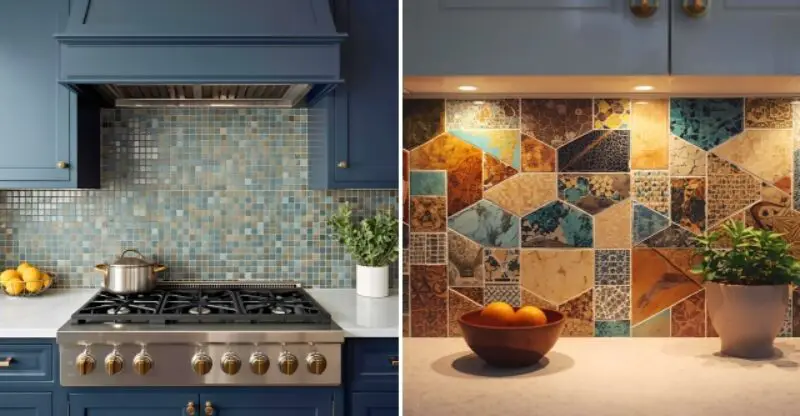How to Tile a Backsplash in a Kitchen
A beautiful backsplash can totally change the look of your kitchen. With so many stunning kitchen backsplash ideas available, it’s like adding a piece of art to your walls! And guess what? You can do it yourself. Tiling a backsplash is a fun project that can save you money. This guide will show you how to do it, one step at a time. We’ll make it super simple, so you feel like a pro. Ready to give your kitchen a fresh, new look? Let’s get started!
1. Gathering Your Tools and Materials
Before you start any project, getting your supplies in order is the key to success. This will prevent mid-project trips to the store and make the job go much smoother. Think of it like gathering ingredients before you cook. Measure the area you plan to tile to calculate the square footage, and always buy about 10-15% extra tile to account for mistakes and tricky cuts.
Here’s a detailed list of what you’ll need:
- Tiles: Choose tiles that you love and that match your kitchen’s style. Ceramic and porcelain are popular choices because they are durable and easy to clean.
- Tile Adhesive: For backsplashes, a pre-mixed mastic is often the easiest for beginners. If you’re using natural stone or glass tile, check the manufacturer’s recommendation, as you may need a thin-set mortar.
- Grout: Grout comes in two main types: sanded and unsanded. Use unsanded grout for joints smaller than 1/8 inch (common with glass or polished stone) and sanded grout for wider joints to prevent cracking.
- Notched Trowel: The size of the notches depends on your tile size. A V-notch trowel is typically used for small backsplash tiles. The notches ensure you apply an even amount of adhesive.
- Grout Float: This is a rubber-faced tool used to press grout firmly into the tile joints.
- Tile Cutter or Wet Saw: A simple snap tile cutter works for straight cuts on ceramic and porcelain. For natural stone, glass, or L-shaped cuts around outlets, renting a wet saw is your best bet.
- Level: A 2-foot level is perfect for ensuring your lines are perfectly straight.
- Tile Spacers: These plastic crosses or T-shapes ensure consistent spacing between tiles for a professional look.
- Sponge and Buckets: You’ll need at least two buckets: one for mixing grout and one with clean water for wiping down tiles.
- Tape Measure: Absolutely essential for accurate cuts and layout.
- Safety Glasses and Gloves: Protect your eyes from tile chips and your hands from the adhesive and grout, which can be irritating.
Having the right tools is super important; it’s one of a few key things I wish I knew before renovating. For a deeper dive into the essential tools for this project, take a look at this helpful guide on tiling tools from The Spruce.
2. Preparing the Wall for Tile
A successful tile job is built on a solid foundation. If your wall is bumpy, dirty, or greasy, your beautiful new tiles won’t stick properly. So, let’s get that wall ready for its makeover!
First, safety is always the priority. Go to your breaker box and turn off the power to any outlets or switches on the wall you’ll be working on. Then, use a screwdriver to remove the cover plates.
Next, give the wall a thorough cleaning. A degreasing cleaner or a simple mixture of soap and warm water works well. Use a sponge to scrub away any grease or grime, especially behind the stove. Once clean, wipe it down with plain water and let it dry completely. If the wall has a glossy paint finish, scuff it up with sandpaper to help the adhesive grip.
If you have an old backsplash, it needs to be removed. This can be messy, but it’s a necessary step. A fresh start is the best start. If removing the old tile damages the drywall, you’ll need to patch it with drywall compound. Apply a thin layer, let it dry, sand it smooth, and repeat if needed. The goal is a perfectly smooth, flat surface. This project is a great chance to think about how to update a wooden kitchen for a more modern feel.
3. Applying the Tile Adhesive
Now for the fun part: sticking the tiles on the wall! This is where your kitchen really starts to transform.
Work in small, manageable sections, about 2×3 feet at a time. If you apply adhesive to the whole wall at once, it will start to dry and form a “skin,” preventing the tiles from sticking.
Take your notched trowel and scoop up some tile adhesive. Spread it onto your first small section of the wall. Then, hold the trowel at a 45-degree angle and comb through the adhesive, creating uniform ridges. These ridges are crucial; they collapse as you press the tile on, creating a solid bond. Getting this step right is crucial, especially if you’re doing a kitchen remodel on a budget, as it ensures a long-lasting, professional finish.
4. Setting the Tiles
With a section of adhesive ready, it’s time to place your tiles. Don’t just stick them on; press each tile into the adhesive with a firm, gentle twisting motion. This ensures full contact and a strong hold.
Start your first row at the countertop, using spacers to maintain a small (about 1/8-inch) gap. This gap will later be filled with caulk, not grout, to allow for movement.
Place your next tile beside the first, using tile spacers to create an even grout line. Continue placing tiles, checking with your level frequently to ensure your rows stay perfectly straight. Don’t assume your countertops are level—always trust your level!
When you get to an outlet or a corner, you’ll need to cut a tile. This is where your tile cutter or wet saw comes in handy. Measure carefully and mark your tile before you cut! A new backsplash can also inspire ideas for how to decorate a kitchen with oak cabinets and tie the whole look together.
5. Grouting the Tiles
After all your tiles are on the wall, you must let the adhesive cure completely. This usually takes at least 24 hours, but check the product instructions. Once it’s fully dry, carefully pull out all the plastic spacers. Now, it’s time to grout.
Grout fills the joints between your tiles, locking them together, protecting your wall from moisture, and giving your backsplash a clean, finished look.
Mix your grout according to the package directions until it has a smooth consistency like peanut butter. Let it sit for a few minutes, then mix it again. Like the adhesive, only mix as much as you can use in about 20-30 minutes.
Apply the grout using your grout float. Hold the float at a 45-degree angle to the tiles and spread the grout diagonally across the joints. This diagonal motion helps pack the grout in tightly. Make sure every joint is completely filled. After you’ve filled all the joints in your section, turn the float to a 90-degree angle and scrape off the excess grout from the tile faces.
Even a small project like this can make a big difference, especially if you want to update a small kitchen on a budget.
6. Cleaning and Sealing
After applying the grout, wait about 15-20 minutes for it to set up slightly. You’ll know it’s ready when it’s firm to the touch. This is the perfect time for the initial cleanup.
Take a damp (not soaking wet) sponge and gently wipe the excess grout off the tiles. Use a light touch and wipe diagonally to avoid pulling grout out of the joints. Rinse your sponge frequently in a bucket of clean water. This first pass is just to clean the majority of the residue.
Let the grout dry for a few hours. A chalky haze will form on the tiles. You can buff this haze off with a clean, dry cloth or microfiber towel. Let the grout cure completely, which can take up to 72 hours. Once it’s fully cured, apply a grout sealer with a small brush. This is a critical step that protects your grout from stains and makes it much easier to clean in the future.
Once you’ve mastered indoor projects, you might be inspired to learn some pro tips for building an outdoor kitchen.
7. Custom Building Products Prism #165 Delorean Gray Grout
Custom Building Products Prism Grout is a fantastic choice for any backsplash project, especially for beginners. It’s a high-performance cement grout that offers consistent, uniform color without mottling. Its rapid-setting formula is perfect for getting the job done efficiently, and its dense composition resists stains and shrinkage.
- Pros:
- Consistent color
- Stain-resistant
- Easy to clean
- Cons:
- Can be a bit more expensive than other grouts
8. Mapei Grout Refresh Universal Grout Colorant and Sealer
If you have an existing tile with stained grout or simply want to change the color without re-grouting, Mapei Grout Refresh is a game-changer. It’s a water-based formula that acts like a paint and sealer in one, allowing you to easily transform the look of your tile by coloring the grout lines.
- Pros:
- Easy to apply
- Lots of color choices
- Seals and protects grout
- Cons:
- Can be time-consuming for large areas
Conclusion
You did it! You successfully tiled your own kitchen backsplash. Step back and admire your beautiful, professional-looking work. It’s a great feeling to complete a home improvement project yourself. Your kitchen now has a fresh, new look that you created, adding both value and personality to your home. Now, it’s time to enjoy your beautiful new space. Happy tiling!



